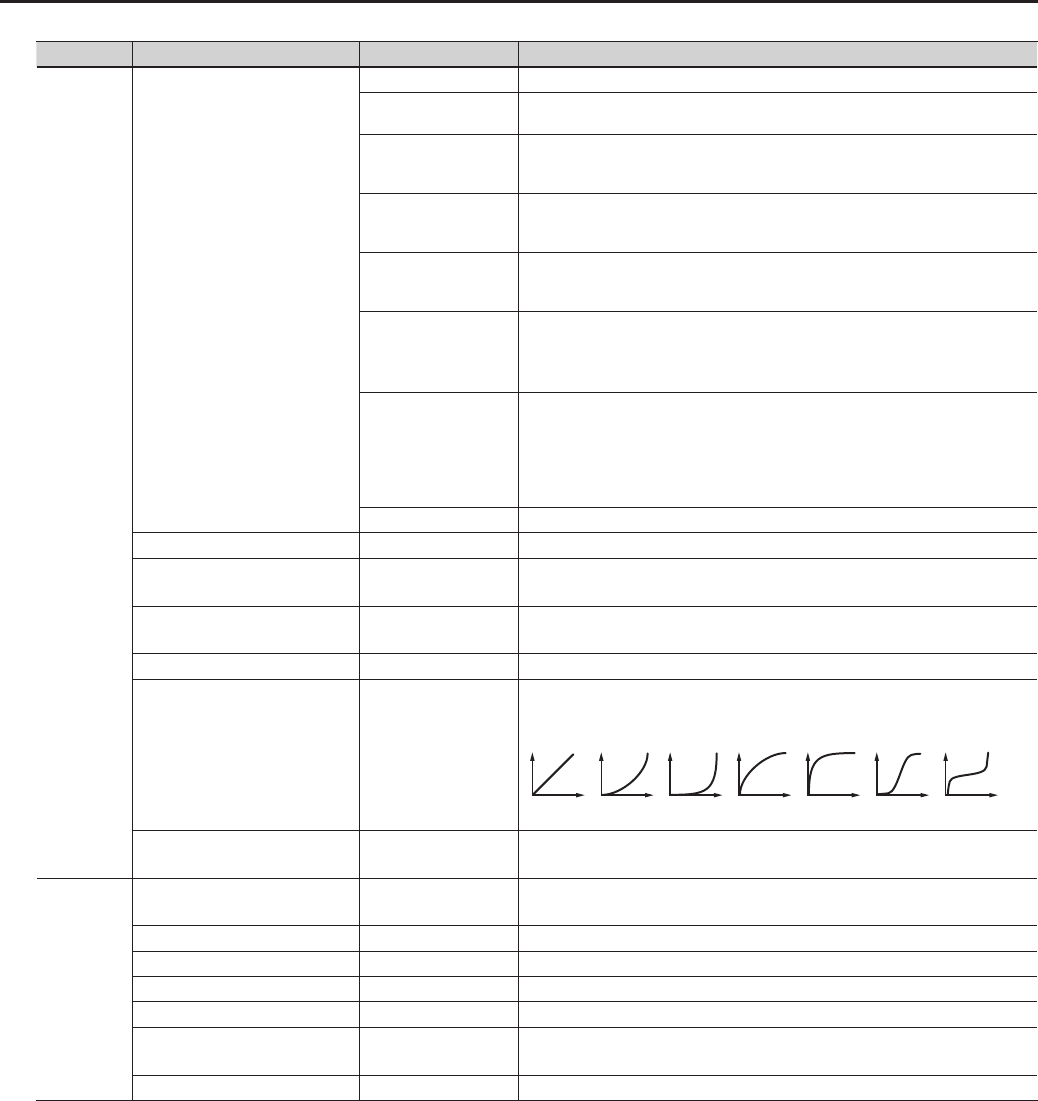
26
Editing the Tones (TONE)
Group Parameter Value Description
FILTER
FILTER TYPE
OFF The lter will not be used.
LPF
Low Pass Filter.
The region above the cuto frequency will be cut, making the sound more mellow.
BPF
Band Pass Filter.
The region around the cuto frequency will remain, and the regions above and below
will be cut. This is a useful way to create a distinctive sound.
HPF
High Pass Filter.
The region below the cuto frequency will be cut. This is appropriate for percussive
sounds with a distinctive high-frequency component.
PKG
Peaking Filter.
The region around the cuto frequency will be emphasized. You can produce a wah
eect by using an LFO to cyclically change the cuto frequency.
LPF2
Low Pass Filter 2.
The region above the cuto frequency will be cut, but the lter sensitivity will be half
that of LPF. This is suitable for simulating instruments such as acoustic piano.
* If “LPF2” is selected, the RESONANCE setting will be unavailable.
LPF3
Low Pass Filter 3.
The region above the cuto frequency will be cut, but the lter sensitivity will change
according to the cuto frequency. This is suitable for simulating acoustic instruments,
but even with the same TVF ENVELOPE settings, it will produce a sound with a
dierent nuance than LPF2.
* If “LPF3” is selected, the RESONANCE setting will be unavailable.
TONE The setting most appropriate for the tone will be used.
CUTOFF # -50–+50 Species the frequency at which the lter will begin to be applied.
RESONANCE -50–+50
Boosts the region near the cuto frequency, giving the sound a distinctive character.
Raising this value excessively may cause oscillation and distortion.
CUTOFF VELOCITY SENS -50–+50
Species the amount by which your playing strength will vary the cuto frequency.
With positive “+” values, stronger playing will raise the cuto frequency.
CUTOFF NUANCE SENS -50–+50 Species how nuances of your performance (p.28) will aect the lter cuto frequency.
CUTOFF VELOCITY CURVE
FIX,
1–7,
TONE
Species the curve by which your playing strength will aect the cuto frequency.
Normally, you should choose “TONE.” The optimal curve for each tone will be used.
If you don’t want the cuto frequency to be aected, choose “FIX.”
1 2 3 4 5 6 7
CUTOFF KEYFOLLOW -200–+200
Species how the pitch of the note you play will aect the cuto frequency.
With positive “+” values, the cuto frequency will rise as you player higher notes.
TVF
TVF ENV DEPTH -50–+50
Adjusts the depth of the TVF envelope.
Higher values will increase the change produced by the TVF envelope.
TVF ATTACK TIME -50–+50 Adjusts the attack time of the lter envelope.
TVF DECAY TIME -50–+50 Adjusts the decay time of the lter envelope.
TVF SUSTAIN LEVEL -50–+50 Adjusts the sustain level of the lter envelope.
TVF RELEASE TIME -50–+50 Adjusts the release time of the lter envelope.
TVF ATTACK VEL SENS -50–+50
Species how your playing strength will aect the lter attack time.
With positive “+” values, stronger playing will shorten the attack time.
TVF ATK NUANCE SENS -50–+50 Species how nuances of your performance (p.28) will aect the lter attack time.


















